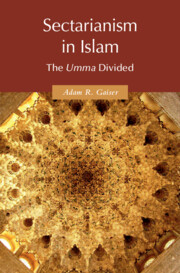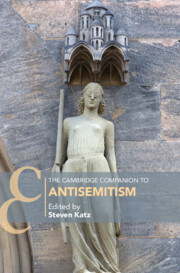57 results
Chapter 10 - Second-generation Afghan Immigrants Navigating Racial and Ethnic Identities in College
- from Part II - Experiences
-
-
- Book:
- Supporting College Students of Immigrant Origin
- Published online:
- 16 May 2024
- Print publication:
- 23 May 2024, pp 200-222
-
- Chapter
- Export citation
5 - Sexuality in Baghdad in the Ninth and Tenth Centuries ce
-
-
- Book:
- The Cambridge World History of Sexualities
- Published online:
- 26 April 2024
- Print publication:
- 16 May 2024, pp 87-107
-
- Chapter
- Export citation
Rooted in turbulence: arguing ethnicity in folk narratives about violence
-
- Journal:
- International Journal of Asian Studies , First View
- Published online by Cambridge University Press:
- 02 February 2024, pp. 1-13
-
- Article
-
- You have access
- Open access
- HTML
- Export citation
Research following trauma in minority ethnic and faith communities: lessons from a study of the psychosocial sequelae of the Christchurch mosque terror attacks
-
- Journal:
- BJPsych Open / Volume 10 / Issue 1 / January 2024
- Published online by Cambridge University Press:
- 11 January 2024, e27
-
- Article
-
- You have access
- Open access
- HTML
- Export citation
British-Bangladeshi Muslim men: removing barriers to mental health support and effectively supporting our community
-
- Journal:
- The Cognitive Behaviour Therapist / Volume 16 / 2023
- Published online by Cambridge University Press:
- 22 December 2023, e38
-
- Article
-
- You have access
- Open access
- HTML
- Export citation
Assessment of health-care workers’ attitudes, knowledge, and skills in the care of critically ill Muslim children in New York
-
- Journal:
- Palliative & Supportive Care , First View
- Published online by Cambridge University Press:
- 14 July 2023, pp. 1-6
-
- Article
-
- You have access
- Open access
- HTML
- Export citation
Palliative team involvement in end-of-life care for Jewish and Muslim children in Jerusalem: A unique clinical and cultural context
-
- Journal:
- Palliative & Supportive Care / Volume 22 / Issue 1 / February 2024
- Published online by Cambridge University Press:
- 06 March 2023, pp. 163-168
-
- Article
- Export citation
Hindu: A History
-
- Journal:
- Comparative Studies in Society and History / Volume 65 / Issue 2 / April 2023
- Published online by Cambridge University Press:
- 20 January 2023, pp. 246-271
-
- Article
-
- You have access
- Open access
- HTML
- Export citation

Sectarianism in Islam
- The Umma Divided
-
- Published online:
- 10 November 2022
- Print publication:
- 24 November 2022
6 - Religion and Ethnicity
-
- Book:
- Arabic Sociolinguistics
- Published online:
- 01 July 2022
- Print publication:
- 07 July 2022, pp 106-130
-
- Chapter
- Export citation

The Cambridge Companion to Antisemitism
-
- Published online:
- 05 May 2022
- Print publication:
- 02 June 2022
2 - Divided Opposition in Egypt (1981–2011)
- from Part I - Members of the Club or the Only Game in Town?
-
- Book:
- Legacies of Repression in Egypt and Tunisia
- Published online:
- 10 March 2022
- Print publication:
- 10 March 2022, pp 55-99
-
- Chapter
- Export citation
4 - Sedition
-
- Book:
- Hidden Histories of Pakistan
- Published online:
- 06 January 2022
- Print publication:
- 20 January 2022, pp 151-198
-
- Chapter
- Export citation
3 - Obscenity
-
- Book:
- Hidden Histories of Pakistan
- Published online:
- 06 January 2022
- Print publication:
- 20 January 2022, pp 94-150
-
- Chapter
- Export citation
5 - Feminist Literary Ethics and Censorship
-
- Book:
- Hidden Histories of Pakistan
- Published online:
- 06 January 2022
- Print publication:
- 20 January 2022, pp 199-245
-
- Chapter
- Export citation
1 - Introduction
-
- Book:
- Hidden Histories of Pakistan
- Published online:
- 06 January 2022
- Print publication:
- 20 January 2022, pp 1-43
-
- Chapter
- Export citation
Muslim pasts and presents: Displacement and city-making in a Delhi neighbourhood
-
- Journal:
- Modern Asian Studies / Volume 56 / Issue 6 / November 2022
- Published online by Cambridge University Press:
- 19 January 2022, pp. 1872-1900
- Print publication:
- November 2022
-
- Article
-
- You have access
- Open access
- HTML
- Export citation
Psychosis in muslim arab population. Case report and article review
-
- Journal:
- European Psychiatry / Volume 64 / Issue S1 / April 2021
- Published online by Cambridge University Press:
- 13 August 2021, p. S323
-
- Article
-
- You have access
- Open access
- Export citation
6 - Sri Lanka
-
- Book:
- Internal Self-Determination in International Law
- Published online:
- 23 July 2021
- Print publication:
- 05 August 2021, pp 155-194
-
- Chapter
- Export citation
4 - Narrative
-
-
- Book:
- Analysing Religious Discourse
- Published online:
- 18 June 2021
- Print publication:
- 08 July 2021, pp 52-69
-
- Chapter
- Export citation



